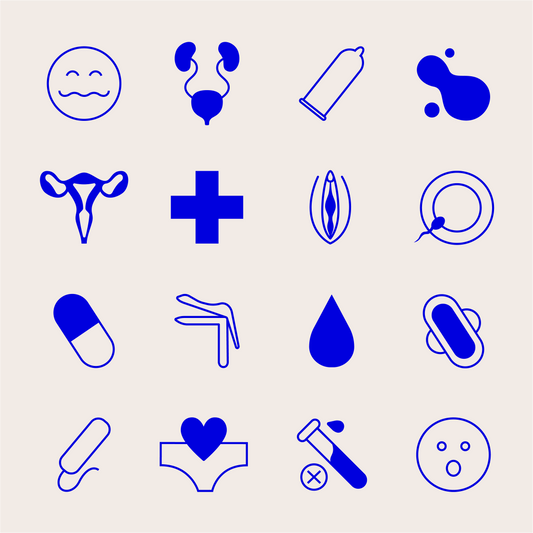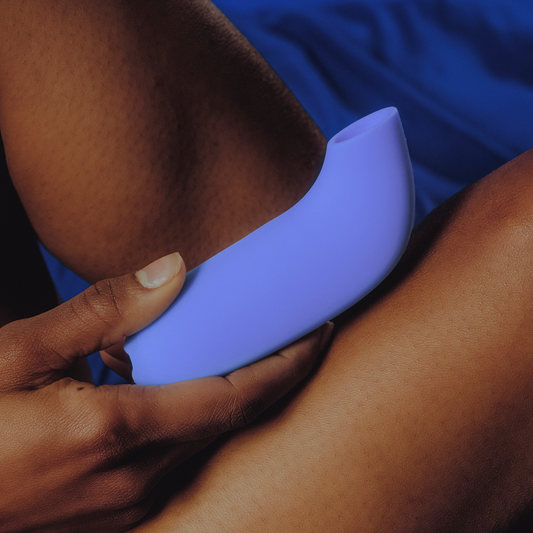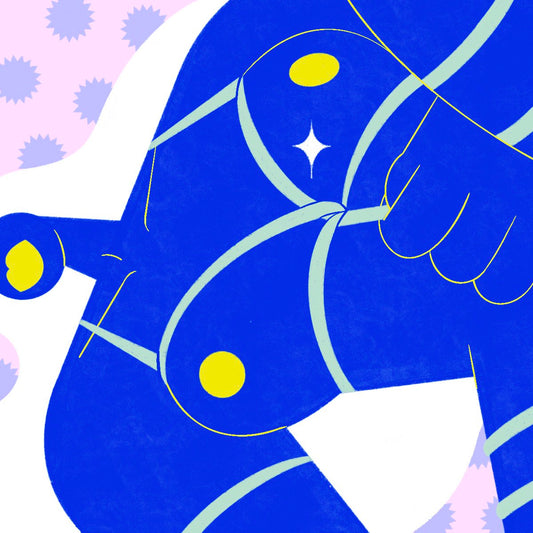Alexandra Fine, Credentialed Sexologist, M. Psych | Written by Dame
What Is Arousal Gel? | Do Many Vulva Owners Have Trouble With Arousal? | How Do Arousal Gels Work? | How to Use Arousal Gels | What about Those Combination Lube/Arousal Gel Products? | Do Arousal Gels Really Work?
If you stop by a sex shop or spend some time surfing Amazon searching for lube, you’ll see so many different types and varieties that you might simply grab a random tube.
And in recent years, the decision has gotten even more complicated. Not only do you have to decide between oil-, water- and silicone-based lubes, warming and cooling lubes, lubes with moisturizers and flavored lubes – you’re now faced with an entirely new category called “arousal gels.”
What’s that all about? Let’s find out.
What Is Arousal Gel?
It’s first important to understand what arousal gel isn’t. Most of these products aren’t actually personal lubricants; in fact, many should not be used in the vagina at all. And while some of these products might offer an extra level of lubrication, that’s not their actual purpose.
Arousal gels are designed to heighten excitement by boosting blood flow to the genitals and stimulate nerve endings. In that way, they increase arousal and sexual pleasure.
Some have called arousal gels (and their close cousins, arousal serums and arousal sprays) the equivalent of “female Viagra.” That’s somewhat of a misconception. These gels don’t work in the same way as the little blue pill, their ingredients and effects vary widely – and you don’t need a prescription for them. You can easily buy them over-the-counter or online.
When you find a pleasure gel that works for you, though, you’ll wonder where it’s been all your life. Most vulva-havers will find that the products improve their sexual experiences, but they can be a godsend for the millions who find it difficult to become sexually aroused naturally.
Do Many Vulva Owners Have Trouble With Arousal?
Yes. Difficulty becoming aroused is so common that it’s actually a recognized medical condition.
Until recently, it was known as “female sexual arousal disorder” (FSAD) or simply sexual arousal disorder (SAD). The American Psychiatric Association, which publishes the authoritative DSM-5 manual, has now combined it with another sexual dysfunction, HSDD (hypoactive sexual desire disorder, or lack of sexual interest). They’re now collectively described as FSIAD, or “female sexual interest/arousal disorder,” even though those who have difficulty with arousal often still experience sexual desire.
There hasn’t been much research showing how common FSAD and FSIAD really are. Studies that have investigated the issue rely primarily on lack of lubrication as an indication of arousal difficulty, and the study most often cited found that nearly one-third of American women suffer with lubrication problems. Other studies have pegged that number at somewhere between six and 21 percent.
More often, FSAD is diagnosed anecdotally. Signs of the disorder include decreased enjoyment of sexual activity; difficulty becoming aroused by sexual intimacy, contact or fantasies; and a lack of feelings – physical or emotional – during sex. Even genital stimulation may not trigger excitement in those with sexual arousal disorder.
The causes of FSAD aren’t clear. It’s believed that psychological, hormonal or physical issues may all contribute to the problem. However, just as in penis-havers, sufficient blood flow to the genital area may be a key reason for arousal difficulties.
And increased blood flow is one of the benefits that an effective “female arousal gel” can provide.
How Do Arousal Gels Work?
First things first, just so we’re clear.
Arousal gels work as sexual enhancers; they’re not intended to create arousal from scratch. It’s up to you to get the ball rolling, whether you normally do it with erotica, sexual fantasies, intimacy, foreplay, sex toys or oral sex. But when you feel it’s time to move to the genital area, these gels can provide pleasure enhancement by increasing sensation, the natural production of lubrication – and the sexual excitement that boosts arousal dramatically.
Most arousal gels increase the delivery of oxygen and blood flow to the genital region. They do it by combining natural ingredients which increase blood flow, with others known to produce stimulating sensations in sensitive areas like the clitoris. That’s where most of these gels should be applied.
Arousal gels often contain the amino acid l-arginine. It’s what’s known as a vasodilator, meaning it can help open constricted blood vessels to promote better blood flow. L-arginine is commonly used as a supplement to treat heart issues, treat high blood pressure – and improve blood flow to penis-havers’ genitals. The substance has been shown to have the same beneficial effect for vulva-havers. Another amino acid, L-ornithine, may be added as well because it helps boost the body’s l-arginine levels.
Most gels are described either as “cooling” or “warming” gels, depending on the body’s natural response to their ingredients. Cooling arousal gels may use peppermint or menthol for that purpose, while warming ones may use extracts like cinnamon, capsicum or damiana.
Each product provides slightly different sensations and lasts for different periods of time, so you may need to experiment with a few gels to determine which works best for your body and libido. Whether a gel is warming or cooling, its tingling effect will also stimulate nerve endings in the genital area, another effect that can increase arousal. (Don’t use products like Icy-Hot just because of the sensations they provide, though. They can hurt sensitive areas of the body.)
A newer group of arousal gels uses either CBD or THC as an active ingredient. They’re designed to relax the body’s intimate areas and encourage greater blood flow and sensitivity. These gels don’t work for everyone and, of course, THC gels may not be legal for sale where you live. You may also want to consult with healthcare professionals or alternative wellness specialists before using CBD or THC “down there.”
You’ll notice that none of the ingredients we’ve mentioned are commonly found in commercially-available lube. That should underscore the point we made earlier: most arousal gels are not intended to be used as a lubricant. Instead, they encourage the body to produce its own natural lubrication due to higher levels of arousal.
There are some combination lube/arousal products now on the market, however. We’ll discuss those in a bit.
How to Use Arousal Gels
The first thing to do is to carefully check the ingredient list on the products label, to make sure you’re not allergic or sensitive to anything in the gel. Then test a small application of the product by putting it on your wrist or thigh and letting it sit for 10-15 minutes or so. That will let you get used to the tingly feeling so you’ll know what to expect. It will also ensure that you don’t have a bad reaction to the gel before you use it elsewhere.
When you’re ready to take the plunge, put a small amount on the tip of your finger and gently massage it into your target area. Clitoral application is usually the safest choice, because these gels are not intended for internal use. It’s also the best choice, because rubbing the clitoris (or the mons pubis, labia or clitoral hood) as the gel takes effect may have a “multiplier” effect on arousal.
Not sure you want to go right to the vulva? Try massaging a little of the gel into the nipples or areolae first. Both vulva and penis owners find that it works wonders there, too.
It can take several minutes before the tingling sensation reaches its peak, so don’t get too impatient. Just relax and enjoy the feelings and (hopefully) your increased sexual arousal. The effects of each application normally last for about twenty minutes.
What about Those Combination Lube/Arousal Gel Products?
Three words: be very careful.
Many of the ingredients used in arousal gels to increase blood flow or sensation, like menthol and damiana, can cause serious irritation when used in the vagina. Those ingredients won’t be used by any reputable company promoting a lube for both internal use and increased sexual arousal, and the excitement level induced by those combo products just won’t be the same.
How can you tell the difference? Arousal gels, serums and sprays will contain some of the ingredients we mentioned earlier. Lubes may contain essential oils like peppermint, but their ingredient lists will be heavy on ingredients like propylene glycol, aloe and glycerin – all known for their lubrication abilities, not their stimulant ones.
Just a few examples: Trojan Premium Arouses and Intensifies Lubricant, which the company says can be used internally, contains just the mild warming agent vanillyl butyl ether. Similarly, K-Y Intense Pleasure Gel Lube uses things like sodium hydroxide and benzoic acid, which may make your VJ tingle but may be more likely to cause irritation than arousal.
On the other hand, Dame’s Arousal Serum contains cinnamon and menthol, and Passion’s Arousal Gel contains l-arginine and menthol. They’re only intended for external use – and they are much more likely to provide a noticeable boost in arousal. Here’s the good news: when the gel does its job well you may have less need for lube, because greater arousal should mitigate problems with vaginal dryness.
When making a purchase decision, there’s another issue to consider as well. Most of these gels contain oil, which means that they can’t be used with either latex condoms (oil can cause them to fail within 30 seconds) or silicone sex toys. Even though you shouldn’t use most arousal gels with penetrative toys, oil can still be an issue if you want to use a clitoral vibrator. Choose a water-based product like AquaGlide stimulating gel instead.
One final disclaimer to look for on the label: arousal gels (and lubes, for that matter) should be paraben-free. Parabens can act like estrogen, potentially disrupting the body’s normal hormone production and affecting the reproductive system. They’re also suspected (but not yet proven) to contribute to the development of breast cancer.
Do Arousal Gels Really Work?
Ask vulva-havers who’ve used these gels, and most will tell you that arousal gels do exactly what they promise. The only scientific evidence available so far, however, has been conducted on behalf of companies that manufacture arousal gels.
Even so, the early returns are good. One survey of vulva owners between the ages of 18 and 59 found that more than three-quarters reported increased genital sensitivity after using arousal gel, and a full 90 percent said that it improved their sexual experience. A related study didn’t provide numbers, but claimed that participants said they had significant improvements in arousal, lubrication, orgasm and satisfaction. Both of those studies were presented to the American Society for Reproductive Medicine.
An earlier preliminary study of a topical arousal gel that’s not on the market, reported much the same thing. It found that participants with FSAD who were given the gel reported 48% more satisfactory sexual experiences than those who were given a placebo.
Whether the evidence is anecdotal or scientific, it’s pretty clear that the theory behind arousal gels makes sense. As long as they’re used as designed, chances are good that these gels can help improve sexual well-being for those with serious medical problems – and boost arousal for those who simply want to have a better time between the sheets.


























